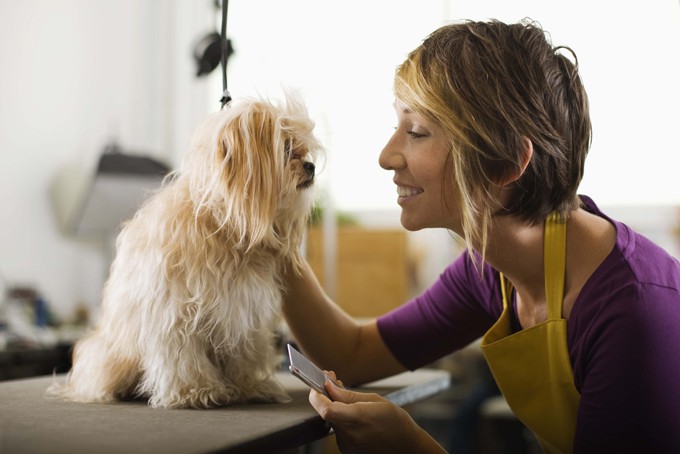When should you start grooming your dog? From day one is the simple answer. Choose a suitable brush for your dog or puppy’s coat type, and spend a little time each day getting the dog used to being brushed. For most breeds of dog, it is a simple task to put the puppy on a table and brush it. Even with the heavier breeds, it is useful to put the dog on a table to begin with, while carrying out routine brushing, combing, checking ears, eyes and mouth, as well as ensuring the anal area is clean and completely free of foreign matter or feces.
Be particularly a vigilant with heavy-coated breeds as they tend to collect debris, such as twigs, which must be removed before more clutter collects, and the anal area must kept scrupulously clean.
How Often?
With a new puppy, it is worth brushing it on a daily basis. This interaction will benefit the puppy and teach it to respond to you and to observe house rules and manners. Grooming interaction will also help the puppy to feel secure, while you will learn more about the character you have chosen to live with for the coming years.
With some breeds that don’t need constant attention to their coats, grooming may later become a weekly occupation rather than a daily one. However, it is wise to brush your puppy every day in the early weeks so that it gets used to being handled and to accepting being groomed.
Early Training
It is essential to train the pup to stand still and to be groomed. If you don’t get it used to the routine when it is young, it will be even harder when the dog is a full-grown adult.
Take the puppy to your chosen grooming spot, stand it up, say “Stand,” wait for just a couple of seconds, then give it a treat and praise it handsomely. Repeat a few times every day, until the pup learns what the word “Stand” means. The treats, praise and cuddles will make the dog look forward to its grooming times.
It is also useful to teach your dog to lie on its side while being groomed, particularly with longcoated breeds. It is a safe and comfortable position, and the dog should feel at ease.
Most puppies are pleased to have the attention of daily grooming. They love the interaction, and handling will be beneficial to their growth and mentality. With only a few minutes a day spent on grooming, the dog will become accustomed to being handled and will be more responsive to its owner or family. With very young puppies, don’t prolong this session or the pup will become bored and will learn to hate the “boring” grooming sessions.
Getting the pup used to being handled will prepare it for being handled by professional groomers, vets and show judges, and will mean it is generally happy and confident around all types of people.
One word of advice to the new puppy owner: check that your new young pup has relieved itself before grooming commences, so that it is not distracted. A pup that needs to urinate will object and whine all the time you are trying to brush it.
Getting Started
Grooming incorporates the brushing, bathing, clipping or stripping of the dog’s coat. The average dog owner rarely
undertakes specialized or professional coat care. For the pet owner, it is sufficient to understand the rudiments of basic brushing and, depending on the breed of dog you have chosen, combing and bathing.
Brushing a dog on a table is far more convenient and less backbreaking than trying to see to its needs while kneeling on the floor. Dogs are usually far better behaved while on a table.
- Place the puppy on the grooming table, and stand close by, with a finger holding its collar to ensure that the dog does not fall or jump off the table.
- Tell the puppy to “Stand,” and praise and reassure it when it stands quietly.
- Commence brushing with your free hand, starting from the head and working systematically down the body, legs and tail.
- Do this for a minute or two, then tell the pup to “Turn” as you turn the pup the opposite way round.
- Again, tell the pup to “Stand” and commence brushing this side, starting with the head and working across.
- Stroke the coat firmly but gently, and repeat the word “Stand” every now and then. Praise and reassure the pup intermittently.
- When you have finished brushing the coat, reward the pup with praise and its favorite tidbit.
- Then lift the pup down onto the floor, and play a game together.
- The puppy will soon look forward to its grooming sessions because they are so enjoyable.
- After a couple of days, when the pup is accustomed to being handled in this way, progress to using a comb after brushing where the coat necessitates this.
Other Checks
Your puppy should also get used to being checked all over — ears, teeth and nails need special attention. Not only will this make your life easier in the long term (your adult will be more compliant), but your vet will thank you for not having a ticklish, nervous or aggressive dog.

